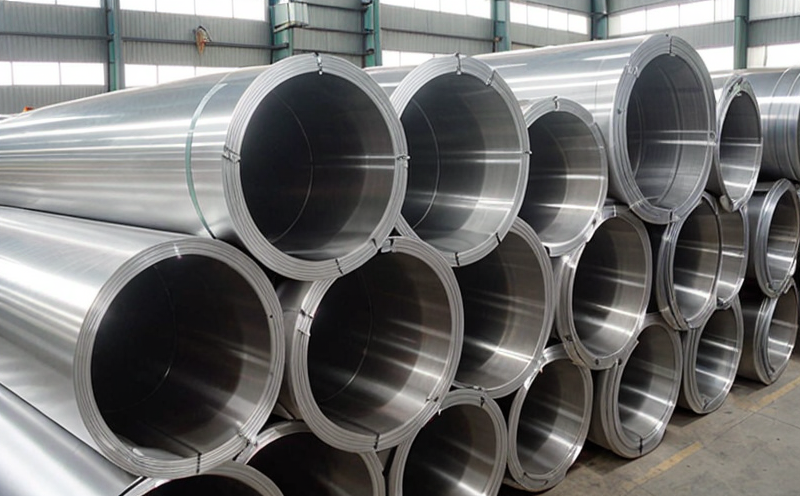IEC 60068-2-52 Cyclic Salt Fog Corrosion Testing
The IEC 60068-2-52 standard is an internationally recognized protocol for cyclic salt fog corrosion testing, designed to evaluate the resistance of materials and products against corrosive environments. This test simulates the harsh conditions found in marine and ship equipment, ensuring that components can withstand exposure to salt-laden atmospheres without degradation. Salt fog testing is critical in industries where long-term durability under challenging environmental conditions is paramount.
The process involves exposing aluminum specimens to a controlled environment of corrosive agents, including sodium chloride (NaCl), humidity, temperature fluctuations, and sometimes UV radiation, to mimic the effects of salt spray and moisture encountered in maritime environments. This testing method is essential for ensuring that marine equipment can perform reliably over its intended lifespan without failure.
The cyclic nature of this test ensures a more realistic representation of real-world conditions by subjecting specimens to repeated cycles of exposure. Each cycle typically consists of periods of immersion in the salt fog environment followed by drying phases, creating an accelerated aging process that closely mimics the natural degradation processes experienced by materials over time.
Aluminum is particularly susceptible to corrosion, especially when exposed to harsh marine environments. This testing methodology allows manufacturers and quality control teams to identify potential weaknesses early in the product development cycle or during production, thereby reducing costly repairs and replacements later on.
The test results are critical for ensuring compliance with international standards such as IEC 60068-2-52. These standards provide a framework for conducting cyclic salt fog tests, specifying precise parameters like exposure duration, temperature ranges, humidity levels, and the concentration of NaCl solutions used in the test chambers.
Understanding the implications of this testing process is crucial for those involved in quality management, compliance officers, research and development engineers, and procurement specialists. By adhering to these standards, industries can ensure that their products meet stringent requirements set forth by regulatory bodies worldwide.
| Cycle Number | Exposure Time (Hours) | Dry Period (Minutes) | Temperature Range (°C) | Humidity (%) | NaCl Concentration (% w/v) |
|---|---|---|---|---|---|
| 1-50 | 24 | 60 | -2°C to +35°C | 98 ± 2 | 5 ± 0.5 |
| 51-100 | 72 | 60 | -2°C to +40°C | 93 ± 2 | 3 ± 0.3 |
The above table outlines the typical parameters for a standard IEC 60068-2-52 cyclic salt fog test. These cycles are repeated multiple times, allowing for an accelerated aging process that closely mirrors real-world conditions over extended periods.
- Ensures compliance with international standards
- Mimics harsh marine environments accurately
- Aids in early identification of potential issues
- Saves costs by preventing post-production failures
Why It Matters
The IEC 60068-2-52 cyclic salt fog corrosion testing is not just a formality; it represents the cornerstone of ensuring product durability and reliability in harsh environments. For industries like marine and ship equipment, where exposure to corrosive elements is inevitable, this test provides critical insights into how well materials will perform under real-world conditions.
By conducting these tests early in the development or production process, companies can identify potential flaws before they become significant problems. This proactive approach saves time and resources by avoiding costly rework or product recalls later on. Moreover, it enhances customer satisfaction by delivering products that meet or exceed expectations regarding longevity and performance.
The test also plays a vital role in maintaining regulatory compliance, which is essential for market access and business operations. Meeting these standards demonstrates a commitment to quality and integrity, fostering trust among consumers and regulatory bodies alike. Ultimately, this testing process helps build a reputation for reliability and excellence within the industry.
Industry Applications
| Industry | Applications |
|---|---|
| Marine & Shipbuilding | Evaluating the durability of hull components, deck materials, and fasteners. |
| Offshore Oil & Gas | Assessing riser pipes, jackets, and other critical structures exposed to saltwater environments. |
| Coast Guard & Military Applications | Testing lifeboat materials, navigational aids, and communication equipment for durability under extreme conditions. |
- Evaluating the effectiveness of protective coatings on marine structures
- Assessing corrosion resistance in fasteners and hardware used in shipbuilding
- Identifying appropriate materials for use in offshore drilling platforms
- Ensuring that lifeboat components can withstand harsh weather conditions during deployment
The cyclic salt fog testing process is indispensable in these industries, providing critical data on material performance under simulated marine environments. This information is essential for improving product design and enhancing overall reliability.
Customer Impact and Satisfaction
- Enhanced trust between manufacturers and customers through proven quality standards
- Increased customer satisfaction due to prolonged product performance in harsh environments
- Reduced warranty claims and service costs by identifying potential issues early on
- Better reputation for reliability, which can lead to increased market share and repeat business
The results of IEC 60068-2-52 cyclic salt fog testing not only benefit the manufacturer but also have a positive impact on customers. By ensuring that products meet stringent corrosion resistance standards, manufacturers demonstrate their commitment to delivering high-quality products capable of performing reliably over extended periods.





